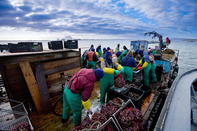A feasibility study ‘Oyster and Mussels Aquaculture in South Africa’, prepared by Advance Africa Management Services for the Department of Agriculture, Forestry and Fisheries (DAFF) in 2017 has developed a financial model for mussel farming.

The financial model for Mediterranean mussel farming is based on a raft production system with a production capacity of 500 tonnes per year. Under the model’s assumptions, it is estimated that a mussel raft operation of the above yield would achieve a profit margin of 35%.
Of course, sales price and production costs are influenced by operational and biological factors and as production increases, certain production costs are diluted. The margin between the sales price and production cost is maximised from 1 500 tonnes per year, the theoretical optimum for mussel production. However, this does not take into account the limited size of the South African mussel market. The study suggests that, in theory, production of 250 tonnes and more may yield a fair profit.
For organic certification of mussels, producers need to look at stock density, the sustainability of seed collection (if no wild seed is used) and following a sustainable management plan according to organic principles. Ireland was one of the first countries to produce organic mussels.
Benefits of mussel farming by small farmers include the decrease of their overreliance on fish stocks, improve food security, diversify their product range and increase income.
A large amount of sea space is now available in Saldanha, since the Saldanha Aquaculture Development Zone was established. Therefore huge growth potential in South Africa’s mussel industry is expected once further international markets are accessed.
By Marinda Louw